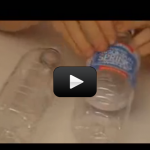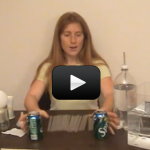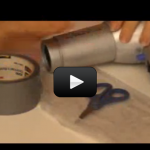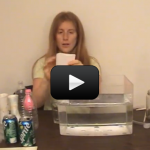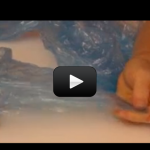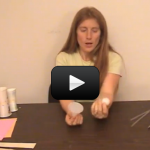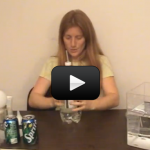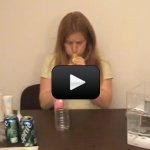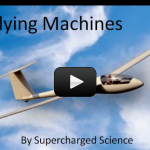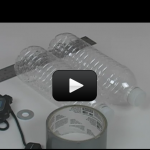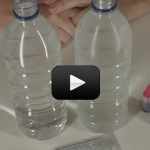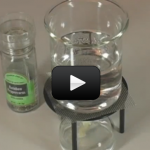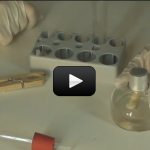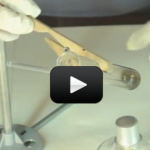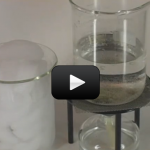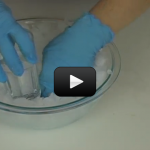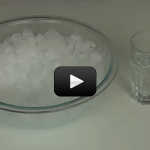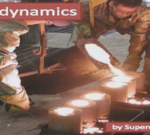Genie in a Bottle
While this isn’t actually an air-pressure experiment but more of an activity in density, really, it’s still a great visual demonstration of why Hot Air Balloons rise on cold mornings. Imagine a glass of hot water and a glass of cold water sitting on a table, side by side. Now imagine you have a way … Continue reading "Genie in a Bottle" |
Soda Can Trick
When air moves, the air pressure decreases. This creates a lower air pressure pocket right between the cans relative to the surrounding air. Because higher pressure pushes, the cans clink together. Just remember – whenever there’s a difference in pressure, the higher pressure pushes. You will need about 25 straws and two empty soda cans … Continue reading "Soda Can Trick" |
Hot Air Balloon
About 400 years ago, Leonardo da Vinci wanted to fly… so he studied the only flying things around at that time: birds and insects. Then he did what any normal kid would do—he drew pictures of flying machines! Centuries later, a toy company found his drawing for an ornithopter, a machine that flew by flapping … Continue reading "Hot Air Balloon" |
Magic Water Glass Trick
Where’s the pressure difference in this trick? At the opening of the glass. The water inside the glass weighs a pound at best, and, depending on the size of the opening of the glass, the air pressure is exerting 15-30 pounds upward on the bottom of the card. Guess who wins? Tip, when you get … Continue reading "Magic Water Glass Trick" |
Diaper Wind Bag
Lots of science toy companies will sell you this experiment, but why not make your own? You’ll need to find a loooooong bag, which is why we recommend a diaper genie. A diaper genie is a 25′ long plastic bag, only both ends are open so it’s more like a tube. You can get three … Continue reading "Diaper Wind Bag" |
Ping Pong Funnel
As you blow into the funnel, the air under the ball moves faster than the other air surrounding the ball, which generates an area of lower air pressure. The pressure under the ball is therefore lower than the surrounding air which is, by comparison, at a higher pressure. This higher pressure pushes the ball back … Continue reading "Ping Pong Funnel" |
Fountain Bottle
As you blow air into the bottle, the air pressure increases inside the bottle. This higher pressure pushes on the water, which gets forced up and out the straw (and up your nose!). Materials: small lump of clay, water, a straw, and one empty 2-liter soda bottle. |
Sneaky Bottles
This experiment illustrates that air really does take up space! You can’t inflate the balloon inside the bottle without the holes, because it’s already full of air. When you blow into the bottle with the holes, air is allowed to leak out making room for the balloon to inflate. With the intact bottle, you run … Continue reading "Sneaky Bottles" |
Special Science Teleclass: Flying Machines
This is a recording of a recent live teleclass I did with thousands of kids from all over the world. I’ve included it here so you can participate and learn, too! Soar, zoom, fly, twirl, and gyrate with these amazing hands-on classes which investigate the world of flight. Students created flying contraptions from paper airplanes … Continue reading "Special Science Teleclass: Flying Machines" |
Magnetic Tornadoes
This lab is a physical model of what happens on Mercury when two magnetic fields collide and form magnetic tornadoes. You’ll get to investigate what an invisible magnetic tornado looks like when it sweeps across Mercury. Materials Two clear plastic bottles (2 liter soda bottles work best) Steel washer with a 3/8 inch hole Ruler … Continue reading "Magnetic Tornadoes" |
Food Dye Currents
When something feels hot to you, the molecules in that something are moving very fast. When something feels cool to you, the molecules in that object aren’t moving quite so fast. Believe it or not, your body perceives how fast molecules are moving by how hot or cold something feels. Your body has a variety … Continue reading "Food Dye Currents" |
Convection Currents
Every time I’m served a hot bowl of soup or a cup of coffee with cream I love to sit and watch the convection currents. You may look a little silly staring at your soup but give it a try sometime! Convection is a little more difficult to understand than conduction. Heat is transferred by … Continue reading "Convection Currents" |
Can Fish Drown?
If you’ve ever owned a fish tank, you know that you need a filter with a pump. Other than cleaning out the fish poop, why else do you need a filter? (Hint: think about a glass of water next to your bed. Does it taste different the next day?) There are tiny air bubbles trapped … Continue reading "Can Fish Drown?" |
Taking the Salt out of the Ocean
This experiment is for advanced students.Have you ever taken a gulp of the ocean? Seawater can be extremely salty! There are large quantities of salt dissolved into the water as it rolled across the land and into the sea. Drinking ocean water will actually make you thirstier (think of eating a lot of pretzels). So … Continue reading "Taking the Salt out of the Ocean" |
Making Clouds
Indoor Rain Clouds Making indoor rain clouds demonstrates the idea of temperature, the measure of how hot or cold something is. Here’s how to do it: Take two clear glasses that fit snugly together when stacked. (Cylindrical glasses with straight sides work well.) Fill one glass half-full with ice water and the other half-full with … Continue reading "Making Clouds" |
Hot Ice Sculptures
Did you know that supercooled liquids need to heat up in order to freeze into a solid? It’s totally backwards, I know…but it’s true! Here’s the deal: A supercooled liquid is a liquid that you slowly and carefully bring down the temperature below the normal freezing point and still have it be a liquid. We … Continue reading "Hot Ice Sculptures" |
Instant Ice
Supercooling a liquid is a really neat way of keeping the liquid a liquid below the freezing temperature. Normally, when you decrease the temperature of water below 32oF, it turns into ice. But if you do it gently and slowly enough, it will stay a liquid, albeit a really cold one! In nature, you’ll find … Continue reading "Instant Ice" |
Special Science Teleclass: Thermodynamics
This is a recording of a recent live teleclass I did with thousands of kids from all over the world. I’ve included it here so you can participate and learn, too! You’ll discover how to boil water at room temperature, heat up ice to freeze it, make a fire water balloon, and build a real … Continue reading "Special Science Teleclass: Thermodynamics" |

